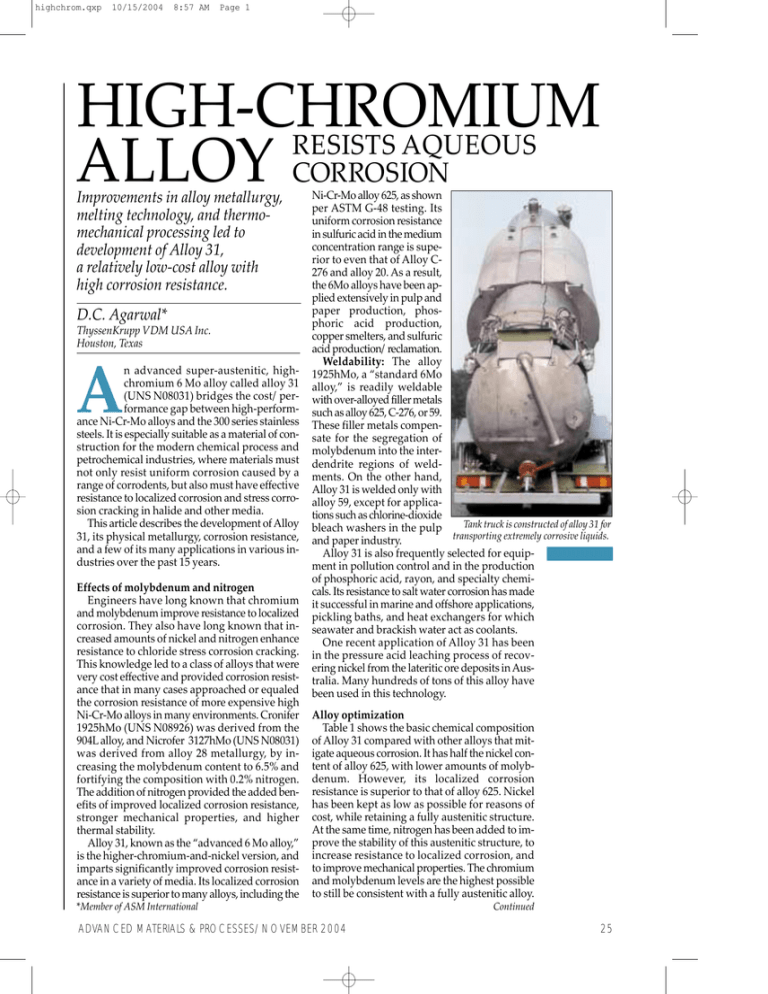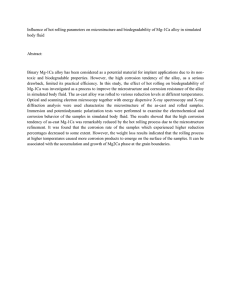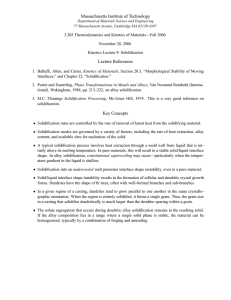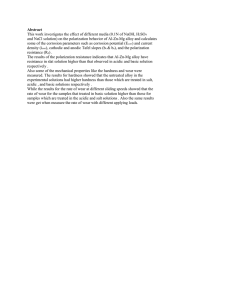high-chromium alloy
advertisement

highchrom.qxp 10/15/2004 8:57 AM Page 1 HIGH-CHROMIUM RESISTS AQUEOUS ALLOY CORROSION Improvements in alloy metallurgy, melting technology, and thermomechanical processing led to development of Alloy 31, a relatively low-cost alloy with high corrosion resistance. D.C. Agarwal* ThyssenKrupp VDM USA Inc. Houston, Texas A n advanced super-austenitic, highchromium 6 Mo alloy called alloy 31 (UNS N08031) bridges the cost/performance gap between high-performance Ni-Cr-Mo alloys and the 300 series stainless steels. It is especially suitable as a material of construction for the modern chemical process and petrochemical industries, where materials must not only resist uniform corrosion caused by a range of corrodents, but also must have effective resistance to localized corrosion and stress corrosion cracking in halide and other media. This article describes the development of Alloy 31, its physical metallurgy, corrosion resistance, and a few of its many applications in various industries over the past 15 years. Effects of molybdenum and nitrogen Engineers have long known that chromium and molybdenum improve resistance to localized corrosion. They also have long known that increased amounts of nickel and nitrogen enhance resistance to chloride stress corrosion cracking. This knowledge led to a class of alloys that were very cost effective and provided corrosion resistance that in many cases approached or equaled the corrosion resistance of more expensive high Ni-Cr-Mo alloys in many environments. Cronifer 1925hMo (UNS N08926) was derived from the 904L alloy, and Nicrofer 3127hMo (UNS N08031) was derived from alloy 28 metallurgy, by increasing the molybdenum content to 6.5% and fortifying the composition with 0.2% nitrogen. The addition of nitrogen provided the added benefits of improved localized corrosion resistance, stronger mechanical properties, and higher thermal stability. Alloy 31, known as the “advanced 6 Mo alloy,” is the higher-chromium-and-nickel version, and imparts significantly improved corrosion resistance in a variety of media. Its localized corrosion resistance is superior to many alloys, including the Ni-Cr-Mo alloy 625, as shown per ASTM G-48 testing. Its uniform corrosion resistance in sulfuric acid in the medium concentration range is superior to even that of Alloy C276 and alloy 20. As a result, the 6Mo alloys have been applied extensively in pulp and paper production, phosphoric acid production, copper smelters, and sulfuric acid production/reclamation. Weldability: The alloy 1925hMo, a “standard 6Mo alloy,” is readily weldable with over-alloyed filler metals such as alloy 625, C-276, or 59. These filler metals compensate for the segregation of molybdenum into the interdendrite regions of weldments. On the other hand, Alloy 31 is welded only with alloy 59, except for applications such as chlorine-dioxide Tank truck is constructed of alloy 31 for bleach washers in the pulp transporting extremely corrosive liquids. and paper industry. Alloy 31 is also frequently selected for equipment in pollution control and in the production of phosphoric acid, rayon, and specialty chemicals. Its resistance to salt water corrosion has made it successful in marine and offshore applications, pickling baths, and heat exchangers for which seawater and brackish water act as coolants. One recent application of Alloy 31 has been in the pressure acid leaching process of recovering nickel from the lateritic ore deposits in Australia. Many hundreds of tons of this alloy have been used in this technology. Alloy optimization Table 1 shows the basic chemical composition of Alloy 31 compared with other alloys that mitigate aqueous corrosion. It has half the nickel content of alloy 625, with lower amounts of molybdenum. However, its localized corrosion resistance is superior to that of alloy 625. Nickel has been kept as low as possible for reasons of cost, while retaining a fully austenitic structure. At the same time, nitrogen has been added to improve the stability of this austenitic structure, to increase resistance to localized corrosion, and to improve mechanical properties. The chromium and molybdenum levels are the highest possible to still be consistent with a fully austenitic alloy. *Member of ASM International ADVANCED MATERIALS & PROCESSES/NOVEMBER 2004 Continued 25 highchrom.qxp 10/15/2004 8:57 AM Page 2 • ASTM coverage. • NACE MRO-175 coverage to level 6. • Excellent fabricability with good thermal stability. Corrosion properties Alloy 31 has excellent resistance to localized corrosion in halide media, both pitting and crevice corrosion. It also provides: • Outstanding resistance to sulfuric acid. • Excellent resistance to phosphoric acid. • Good resistance to nitric and nitric/hydrofluoric acid mixtures. • Excellent resistance to chlorine dioxide media in the pulp and paper industry. • Excellent resistance to both oxidizing and reducing media. • Good resistance to stress corrosion cracking. • ASME SCVIII Div 1 coverage to 430°C (800°F). Resistance to acids Sulfuric acid: Table 2 gives the uniform corrosion data at various concentrations and temperatures. As is evident , Alloy 31 exhibits excellent corrosion resistance in dilute and medium concentration up to 100°C (212°F). At concentrations greater than 80% and at 100°C (212°F) and over, the alloy becomes active. However, in the presence of oxidizing species such as ferric ions, the range of Alloy 31 passivity can be expanded. Table 1 — Metallurgical optimization of Alloy 31 vs. some other alloys Alloy Ni Cr Mo Fe Others PRE* 316L 904L 1925hMo 20 825 28 31 G-3 G30 625 C-276 59 12 25 25 38 40 31 31 48 45 62 57 59 17 21 21 20 22 27 27 23 29 23 16 23 2.3 4.8 6.5 2.4 3.2 3.5 6.5 7 5 9 16 16 66 48 46 34 31 36 32 20 15 3 5 <1 — Cu Cu, N Cu, Cb Cu Cu Cu, N Cu, Cb Cu,W,Cb, Ta Cb W — 24 37 48 29 32 38 54 45 45.5 52 69 76 *PRE = Pitting Resistance Equivalent = % Cr + % (3.3 Mo) + 30N Table 2 — Corrosion rate in sulfuric acid at various temperatures in mils/year H2SO4 60°C (140°F) Percent, % 80°C (175°F) 100°C (210°F) Alloy 20 Alloy C276 Alloy 31 Alloy 20 Alloy C276 Alloy 31 Alloy 20 Alloy C276 Alloy 31 <5 <5 >5 5 <1 <2 <2 <1 <0.1 <0.1 <0.1 0.2 10 10 11 18 4 3 4 15 <0.1 <0.2 0.4 0.8 >25 >25 >50 >50 >1 10 11 240 0.3 0.6 1 240 20 40 60 80 Table 3 — Corrosion rate of various alloys in phosphoric acid in mm/year Test media 52% P2O5 + Impurities 52% P2O5 30% P2O5 44% P2O5 54% P2O5 Very pure + Impurities + Impurities + Impurities Temp., ° C Alloy 31 Alloy 926 Alloy 28 Alloy G-3 Alloy 30 80 120 116 80 116 116 0.02 0.78 0.08 (1) 0.015 — 0.05 (1) 0.06 — — 0.03 — — 0.08 — 1.2 — — 1.4 — — 0.28 — 0.55 0.40 — — 0.10 — 0.18 0.20 Table 4 — Critical pitting and crevice corrosion temperature Alloy 316 904L 20 825 G-3 1925hMo 625 33 30 31 Critical pitting corrosion temp., °C (°F) 15 (60) 45 (113) 15 (59) 30 (86) 70 (158) 70 (158) 77.5 (171.5) 85 (1850 75 (167) 85* (185) Critical crevice corrosion temp., °C (°F) <0 (32) 25 (77) <10 (50) <5 (41) 40 (104) 40 (104) 57.5 (135.5) 40 (104) 50 (122) 65 (149) Pitting resistance equivalent (PRE)** 24 37 29 32 45 48 52 50 46 54 Per ASTM G-48 (10% FeCl3 ) * Above 85° C, the 10% FeCl3 solution chemically breaks down ** PRE = 5%Cr + 3.3(%Mo) + 30N 26 ADVANCED MATERIALS & PROCESSES/NOVEMBER 2004 highchrom.qxp 10/15/2004 8:57 AM Page 3 Hydrochloric acid: In hydrochloric acid, Alloy 31 is resistant at room temperature up to a concentration of 8%, with corrosion rates below the 0.13 mm/y (5 mpy). From 8% HCl to 40% HCl, the corrosion rate at room temperature is between 0.13 and 0.5 mm/y (5 mpy to 20 mpy). At a higher temperature of 80°C (175°F), the alloy is resistant up to 3% concentration. Hence, in many chemical processes where only traces of HCl are present, Alloy 31 presents a good alternative over more expensive nickel alloys of the “B” or “C” family that contain higher amounts of molybdenum. Nitric acid: Tests were conducted in 67% boiling HNO3 (Huey test). Even after ten boiling periods of 48 hours each, Alloy 31 exhibited a very low corrosion rate of only 0.1 mm/y (4 mpy). On welded samples (filler metal was alloy 625), the corrosion rate increased to 0.2 mm/y (8 mpy), still an acceptable rate. Despite the high molybdenum content of 6.5%, it exhibits excellent resistance in strongly oxidizing media. Phosphoric acid: Laboratory tests in synthetic phosphoric acid media with no solids present (Table 3) did indeed confirm that the corrosion resistance of Alloy 31 was superior to those of alternative alloy 926 (UNS N08926, a standard 6Mo alloy) and alloy 28 (UNS N08028). It was comparable or even better than alloy G-30 (UNS N06030). These tests also confirmed that corrosion of metals in phosphoric acid could increase rapidly at or above a certain threshold temperature, which appears to be around 120°C (250°F). Actual plant coupon tests in wet phosphoric acid also confirmed the superior behavior of Alloy 31 over alloy G-30. A current application with approximately 780 tubes in concentrated 46% to 54% P2O5 is demonstrating excellent performance. The plant saved over $100K by selecting Alloy 31 as the heat exchanger material over alloy G30. Pitting/crevice corrosion One of the key service criteria after uniform corrosion is the ability to resist pitting and crevice corrosion in the process side, which is primarily acidic low pH with chlorides. ASTM G48 is one of the standard laboratory tests established to evaluate this type of corrosion, and it is being increasingly applied in specifications for sea/offshore and sour gas applications. The higher the critical pitting temperature (CPT) and crevice corrosion temperature (CCT), the better is the resistance to localized corrosion. Table 4 lists the CCT and CPT for a variety of alloys. Alloy 31 in this group had the highest localized resistance, even better than the Ni-Cr-Mo alloy 625. Many tests over the years have been conducted on Alloy 31 at Laque Center for Corrosion Testing, Wrightsville Beach, N.C. For example, up to 60 days of multiple crevice assembly tests in filtered seawater at 30°C (86°F) showed that the alloy has good resistance to crevice corrosion attack. Of the various test conditions, the real world is most closely approximated when chlorinated sea-water is pumped through pipe loops. Such tests have been carried out with water from both the Baltic Sea and the North Sea. In the Baltic Sea test, Alloy 31 was resistant at temperatures up to 40°C (100°F) and chlorine levels up to 2 ppm. Only at a temperature of 50°C (120°F) and a chlorine level of 2 ppm did alloy 31 show slight crevice corrosion on two out of the ten flange joints. In contrast, when placed in North Sea water, which has much greater salinity, the alloy was resistant up to 45°C (110°F) at a 1.5 ppm level. However, at a temperature of 50°C (120°F) and a chlorine level of only 0.5 ppm, it showed crevice attack on three out of the ten flange joints. Intergranular corrosion resistance Resistance to intergranular attack has been determined by the TTS (time-temperature-sensitization) plot when tested per the ASTM G28A test method. Corrosion depth of greater than 0.002 in. (50 microns) only develops after a few hours (between two and three hours) at the nose of the plot (between 650 and 700°C, 1200 and 1290°F). To complement this result, welded samples of 6 mm plate were tested in the ASTM G28A test. The weld metal, heat affected zone, and the base metal were totally free from intergranular attack. Hence the alloy can be and is used in the welded condition without the need for any post-weld heat treatment. In the Baltic Sea test, Alloy 31 was resistant at temperatures up to 40°C (100°F) and chlorine levels up to 2 ppm. Stress corrosion cracking Austenitic stainless steels are susceptible to stress corrosion cracking in chloride media. Alloy 31 will also crack in boiling 45% MgCl2 solution. However, this environment is not encountered in real world situations. Alloy 31 was tested in boiling 62% CaCl2 solution, an environment more closely related to the real world, for more than 2000 hours and exhibited total resistance to stress corrosion cracking. Alloy 31 was also tested under sour gas conditions (10 bar H2S at 232°C, 450°F). After 35 days, the corrosion rate was 0.01 mm/y with no signs of any pitting or stress corrosion cracking at a stress of 95% of 0.2% yield strength. This alloy also complies with the NACE MRO-175 up to level 6. Fabrication and specifications Alloy 31 is readily fabricated by the standard methods for stainless steels. It is weldable by all conventional processes, including GTAW, GMAW, SWAW, and plasma arc welding. The recommended filler metal is alloy 59, which has an AWS A5.14 designation ErNiCrMo-13 and AWS 5.11 designation ENiCrMo-13. Greater details on fabrication are listed in the Alloy 31 data sheet. This alloy is covered in all the standard ASTM specifications, NACE MRO-175 specification, and ASME SC II, Part D for pressure vessel applications. For more information: D.C. Agarwal, ThyssenKrupp VDM USA, 11210 Steeplecrest Drive #120, Houston, TX 77065-4939; tel: 281/955-6683; fax: 281/9559809; e-mail: dcagarwal@pdq.net; Web site: www. thyssenkrupp.com. ADVANCED MATERIALS & PROCESSES/NOVEMBER 2004 27




